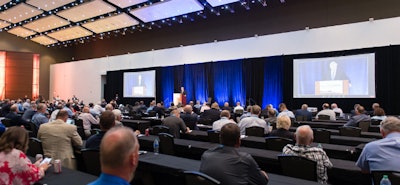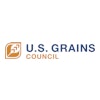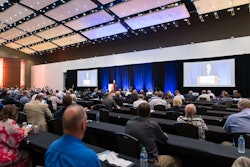
Ray Defenbaugh, who passed away in January 2020, and Tom Sleight, longtime CEO, were honored with USGC’s Lifetime Achievement Award this week during the organization's 61st Annual Board of Delegates Meeting.
Ray Defenbaugh
When asked what they remember most about U.S. Grains Council (USGC) Board of Directors member Ray Defenbaugh, friends and family are quick to smile and share about his gifts for connecting with people.
“He could talk to anybody, no matter who you were or where you were from,” reflects his daughter, Deborah Green. “He could be sitting talking in a field and, in an hour, he could have a hundred people around him for no reason. People were just drawn to him.”
Led by a passion for agriculture that started at an early age, he wore many professional hats during his life, including high school agriculture teacher, loan officer and farm manager. But it was his leadership in the ethanol sector that brought his gifts to USGC.
“Ray was a calming voice and a uniting force within our industry,” said Ryan LeGrand, USGC president and CEO. “He meant so much to USGC. We need to continue to remember his legacy, his kindness and his thoughtful reminders that we need to work together for a common cause.”
Among other roles, Defenbaugh was the founding member, president, CEO and chairman of Big River Resources, LLC, which includes ethanol plants, grain elevators and other facilities in Iowa, Illinois and Wisconsin.
Defenbaugh served as the agribusiness/ethanol and co-products sector director on the USGC Board and played an important role in establishing USGC’s ethanol promotional work overseas.
"Ray led the Ethanol Advisory Team for USGC as our global effort was getting underway," said Brian Healy, USGC director of global ethanol market development. “He helped usher in the deep support and collaboration that we see today.”
Defenbaugh's legacy is felt in both USGC's work and the USGC community - a legacy members were able to reflect on as his family accepted the Lifetime Achievement Award on his behalf.
“Ray was a vocal advocate for our work around the world and instrumental in bringing USGC’s ethanol program to where it is today,” said Darren Armstrong, farmer from North Carolina and former USGC chairman. “He was a larger-than-life figure in his family, his community and the entire ethanol industry and is dearly missed.”
Tom Sleight
汤姆手法从未想过一个电话change his career path forever. Fast-forward nearly 40 years, and the former USGC president and chief executive officer (CEO) was recognized with the organization’s Lifetime Achievement Award.
“Tom gave nearly 30 years of his life to the U.S. Grains Council. I often joke that we tested his blood on the way out, and his blood type was ‘USGC positive,'” said Ryan LeGrand, current USGC president and CEO. “He lived and breathed the Grains Council and our mission.”
“I remember it very vividly,” Sleight said of how he came to join USGC. “It was a Saturday morning. I was on my way to go skiing in Montana when I got a call from the vice president of the Council at the time. The next thing I knew, I was in Washington D.C., completed the interview process, and they offered me a job. Boom.”
Raised as the eighth generation on his family’s New York farm, Sleight was in the grain business in North Dakota and Montana before joining USGC in 1983 as a program manager, working with USGC’s newly opened China office.
It wasn’t long, though, before his journey would take him to new corners of the globe. In the mid-1980s, he accepted a promotion to regional director in the Council’s Vienna office, leading activities in Eastern Europe and the Soviet Union.
“That was probably the most exciting time of our personal and professional lives,” Sleight said. “It was right during the Gorbachev years, and change was afoot constantly. It was a very, very stimulating time to try to figure out programs that could help boost agricultural development in that part of the world and then boost markets for U.S. feed grains.”
Eventually Sleight returned to Washington D.C., where he served as director of international operations, first for Eastern Europe and the Middle East and, later, for Asia. It was a fresh vision from the USGC's leadership, though, that would take him into a new aspect of the organization.
“Leadership at the time wanted to kind of shake things up a little bit. You had the international side, and you had the domestic U.S. membership side of things. They wanted to cross-pollinate more,” Sleight remembered.
Sleight was promoted to executive director for membership administration and communications, a role which would expose him to new people and experiences, like annual meeting planning and association management.
“地主,预算…你知道的,有趣的uff!” he joked.
After more than 15 years in various positions within USGC, Sleight felt the pull to try something new. In 1999, he left the Council and took on roles with the Virginia Department of Agriculture and the New York Farm Viability Institute.
Of the latter, he said, “I grew up as a New York farm boy, and I never thought I’d be able to go back home."
And then, the call came from USGC once again.
USGC’s CEO at the time was looking for a new vice president. Sleight accepted the role in 2010 and, in 2012, was elevated to CEO himself – a position he would hold until his retirement in 2019.
“The board had a lot of confidence in me and tasked me with righting the ship and keeping it running smoothly,” he said. “That guided my time as CEO, learning what folks really wanted and cared about.”
While his tenure wasn’t always easy – he highlighted policy changes around the North American Free Trade Agreement (NAFTA) and recent anti-dumping and countervailing duty suits as particularly contentious – he said he’s proud of USGC’s resistance to complacency.
“I always felt USGC needed to be nimble, needed to be relevant,” he said. “There were times in my career where you could feel people drifting off, not listening to the members and not striving to be relevant.
"But it’s a constantly changing environment, and what I’m most proud of is being able to unite different sections of our membership – agribusiness, checkoffs, integrate them with our international offices and national programs – and make everyone really appreciate the oneness of USGC and how it is all connected.”
Connection was at the heart of that fortuitous phone call in 1983 that would bring him to USGC, and it continues to be at the heart of his legacy within the organization.





















